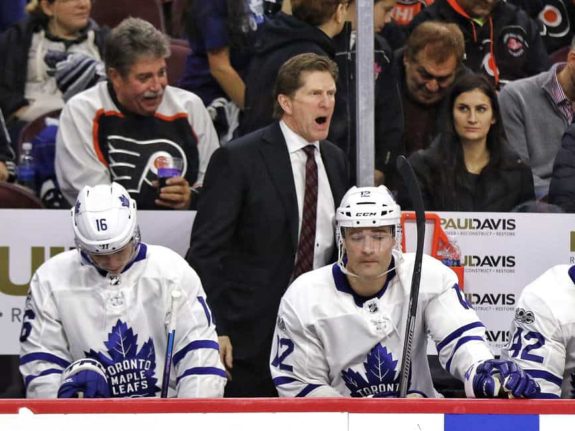Hockey is the bitter old man of the sporting world, always pining for days gone by.
One of the most pined-for eras is the 1980s, highly desirable on account of its high levels of scoring, legendary dynasties and obscene amount of generational talent.
Never mind the goaltending, the Cooperalls and the fact there were only five or six teams with a realistic shot at winning anything. Nope, not important.
The recent return to National Hockey League prominence of offense-heavy teams, the Toronto Maple Leafs included, has undoubtedly given the league a shot of adrenaline. The modern game is (on most nights) faster, more skillful and, ultimately, more exciting than ever before (unless you spent your Saturday night watching the Florida Panthers play the Montreal Canadiens, like I did).
However, whenever a team is clearly built for offense, questions arise as to the defense and goaltending. Which is fair enough; this year’s Edmonton Oilers are living proof that, to paraphrase Steve Dangle, it’s okay to have great goaltending, but it’s not okay to need it.
So, with that said, just how much pressure are the Leafs placing on the shoulders of Frederik Andersen and Curtis McElhinney (and now Calvin Pickard, apparently)?
Shots Against Leaf’s Goalies
The Leafs allow the third-most shots per game in the NHL at nearly 34 per night, while they rank dangerously close to the bottom-third in shots for. So that’s not good. That said, their talent level on offense is good enough to make those fewer shots count.
But how has this imbalance impacted their goaltenders? Let’s start with five-on-five.

Weirdly, Andersen faces 2.5 more shots per game than does McElhinney. Outside of a statistical anomaly (McElhinney has only played seven games this season after all, a very small sample size), this difference could be explained by the Leafs feeling the need to play more conservatively in front of their backup netminder.
But that explanation is not satisfactory, as said difference seems to be made up almost entirely of low-danger opportunities. Interesting, given that conventional wisdom would suggest the opposite; that opposing teams would want to pepper a seldom-used backup with shots from anywhere and everywhere.

Now, while it is noteworthy that both Leafs goalies are above-average in several save percentage categories – suggesting the possibility of future regression back towards the norm, they aren’t giving up any more high-danger – or even medium-danger – shots than the average team.
It shouldn’t be worrisome when much of the difference in shots allowed is made up of low-danger opportunities. Even if a correction does occur (such as with McElhinney’s sparkling high-danger mark), the Leafs shouldn’t feel the need to substantially change their game.
It’s also possible the Toronto scouting staff did their due diligence (is Curtis McElhinney the new Chad Bradford?!) and have simply assembled a very solid goaltending tandem (for a very reasonable price, I might add).
Leafs’ Penalty Kill
So, what about when the Leafs are down a man (or two)?

As you can see, Andersen handles a pretty average workload in comparison to the league average when the Leafs are shorthanded, while McElhinney, inexplicably, seems to face many more shots than his batterymate (the opposite is true at five-on-five). Granted, he’s played in far fewer games than Andersen, so one would expect his totals to move more into line with Andersen’s over time.

In any case, the workload doesn’t seem to have fazed the veteran McElhinney, who’s posted save percentages well-above the NHL average in all three categories. Andersen, for his part, has also excelled when his team is shorthanded, with his tremendous .839 SV% on the penalty kill a full 102 points higher than the league average.
Interestingly, Andersen’s low-danger SV% is, as it is at five-on-five, lower than the league norm.
Starting Games on Time
For all Mike Babcock’s frustration with his team not starting “on time,” the Leafs allow about as many shots in the first as any other period (overtime excluded, obviously).

I ran the numbers: in their 39 games thus far, the Leafs average 11.2 shots allowed in the first, 11.5 in the second and 10.4 in the third.
Naturally, this analysis doesn’t take into account the amount of scoring chances (which isn’t a perfect statistic itself) they allow, but you get the idea. The Leafs simply don’t seem to be especially suspect defensively at any particular time.
Oh, and if you’re wondering about the Leafs’ offense early in games? They lead the league in first-period goals, so it’s not as though Andersen and McElhinney have to wait long for support.
Maple Leafs Goaltenders Fare Reasonably Well
When you think of an offense-laden team, you think of a team that often sacrifices defense to trade scoring chances, relying on offensive production and timely saves to prevail.
Though high-scoring games, like the wildly entertaining 8-5 defeat of the Rangers back in early October, certainly captured the attention and imagination of the hockey world, the Leafs are, really, pretty average defensively. Obviously, “average” isn’t ideal, but with the offensive weaponry Toronto has, it should be more than good enough.
Even though there’s a perception the Leafs are a carefree, offensively focussed, defensively lackadaisical team that hangs their goaltenders out to dry, the evidence simply doesn’t back that up.
Nor does the evidence support needing to start Andersen in 31 of 39 games, which puts him third in NHL minutes played heading into Saturday night. Not only has McElhinney proven to be a capable backup, the team does not seem to play substantially different defensively in front of him.

So no, the Leafs (generally) don’t put too much pressure on their goalies. Yes, they give up a lot of shots, but the number of high-danger shots allowed is no higher than the league average. If anything, Andersen and McElhinney have things a little bit easier than most, given their team’s potential to provide plentiful run support. If they give up a goal, even if it’s a stinker, they can be reasonably sure their teammates will bail them out.
It’s not like the Leafs have been fantastic in their own end or anything but, given their outstanding offensive prowess, their defensive game is more than good enough to win.
(All advanced stats are thanks to Corsica.)